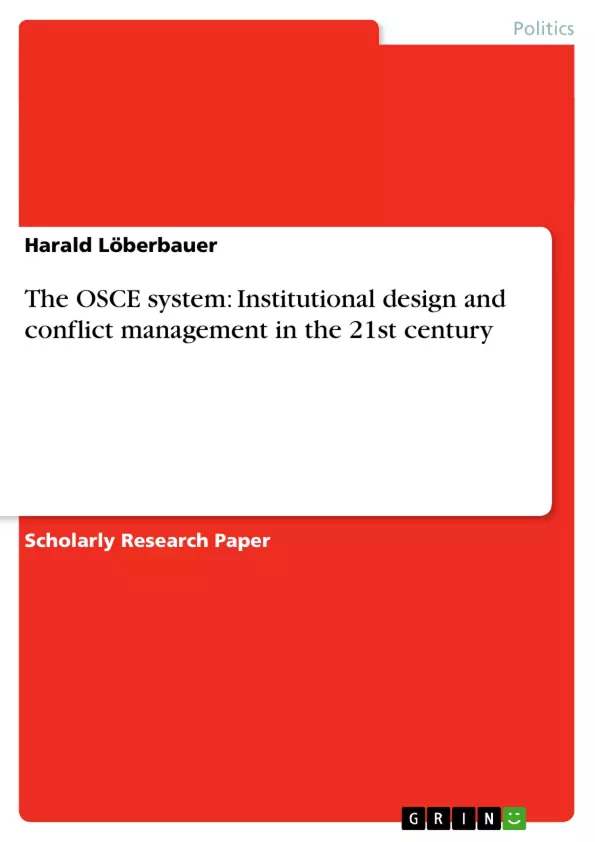The OSCE is an international organization, which acts on a regional security level. It is the largest regional security organization in the world with 56 participating member states and is integrating the geographical area of Eurasia and North America. The object of research is to find out how the organization is designed, how it functions in conflict management and what future perspectives of the OSCE look like.
This research is basically divided into two parts (III The OSCE as an international organization and IV The OSCE in the 21st century). After defining the most important terms for this paper, the first part of the research will analyze the institutional design, the structure and the historic development of the OSCE with the aim to go into detail into conflict management mechanisms. Case studies of missions of the OSCE are involved in the research but they are mentioned to supplement the empiric analysis of conflict management of the OSCE. The second part of the analysis should give a future perspective for the OSCE. The OSCE in the 21st century would be completely different from the OSCE of the 1970s. Therefore in this part the focus is set on an analysis according to international relations theory and international law to show what the differences between the OSCE of the Cold War and the OSCE after 9/11 are. Strength and limitations of the OSCE are shown in order to describe reform recommendations and future perspectives of the organization from a political scientist and international lawyer point of view.
Inhaltsverzeichnis (Table of Contents)
- I Introduction
- 1.1 Object of Research and Structure
- 1.2 Main Questions
- 1.3 Method
- II General Definitions
- 2.1 The international state system
- 2.2 Conflict, Crisis and War
- 2.3 The difference between a conference and an organization
- III The OSCE as an international organization
- 3.1 International and Regional Institutions in Conflicts and Crises
- 3.1.1 Different mandates
- 3.1.2 Security strategies
- 3.2 Development of the OSCE
- 3.3 Structure of the OSCE
- 3.3.1 Budget of the OSCE
- 3.3.2 OSCE decisions
- 3.3.3 Mechanisms of the OSCE
- 3.3.3.1 Conflict resolution mechanisms
- 3.3.3.2 Conflict prevention mechanisms
- IV The OSCE in the 21st century
- 4.1 OSCE strengths and limitations
- 4.1.1 Regional issues and missions
- 4.2 Future perspectives and reform recommendations
Zielsetzung und Themenschwerpunkte (Objectives and Key Themes)
This research paper analyzes the OSCE as an international organization, examining its institutional design and its role in conflict management in the 21st century. It explores the OSCE's development, structure, mechanisms, and challenges, considering its strengths and limitations within a changing global landscape.
- The OSCE's institutional design and its effectiveness in managing conflict in the 21st century.
- The evolution of the OSCE from its origins as the Conference on Security and Co-operation in Europe (CSCE).
- The OSCE's various mechanisms for conflict resolution and prevention, including its strengths and weaknesses.
- The challenges faced by the OSCE in addressing regional issues and fulfilling its mandate in a complex and dynamic international environment.
- Potential future perspectives and reform recommendations for the OSCE to enhance its effectiveness in conflict management.
Zusammenfassung der Kapitel (Chapter Summaries)
The introductory chapter establishes the research paper's objective, outlines its structure, and defines the key questions it aims to address. It also details the research methodology employed. Chapter II introduces fundamental concepts of the international state system, defining conflict, crisis, and war, and elucidates the distinction between a conference and an organization.
Chapter III delves into the OSCE's role as an international organization, examining the mandates and security strategies of international and regional institutions within the context of conflicts and crises. It traces the historical development of the OSCE and elaborates on its structure, budget, decision-making processes, and mechanisms for conflict resolution and prevention.
Chapter IV discusses the OSCE's performance in the 21st century, analyzing its strengths and limitations, particularly in addressing regional issues and undertaking missions. This chapter also explores future prospects for the OSCE and proposes recommendations for potential reforms.
Schlüsselwörter (Keywords)
The paper's main keywords and focus topics include: international organizations, conflict management, security, institutional design, OSCE, CSCE, conflict resolution, conflict prevention, regional security, transatlantic relations, and international relations theory. The paper also examines the OSCE's response to specific regional challenges such as the conflicts in the Balkans, the Caucasus, and Central Asia.
- Citar trabajo
- Harald Löberbauer (Autor), 2006, The OSCE system: Institutional design and conflict management in the 21st century, Múnich, GRIN Verlag, https://www.grin.com/document/71954



